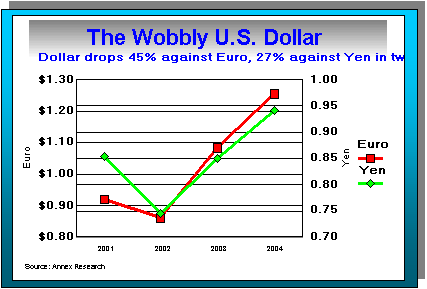
Home |
Headlines | Annex Bulletins
| Index 2004 | About
Founder | Search | Feedback
| Clips | Activism
| Client quotes | Workshop | Columns
| Subscribe ![]()
The copyright-protected information contained in the ANNEX BULLETINS and ANNEX NEWSFLASHES is part of the Comprehensive Market Service (CMS). It is intended for the exclusive use by those who have contracted for the entire CMS service.
An Open Client Edition
![]()
GLOBAL TRENDS
Updated 1/27/04, 12:30 p.m. MST (adds "New IBM Layoffs")
Annual Analysis of U.N. Report on Global Direct Investments
China Now Bigger Than
the
U.S.!
"War on Terror" Exacts Its Toll: Foreign Investors Shun U.S. Economy
PHOENIX, January 26
– Perhaps the biggest stealth casualty of Washington’s “war on
terror” is the U.S. economy. Not
only is the U.S. dollar weak (it has dropped 45%
against the Euro in two years; 23% against the yen); not only is our soaring
national debt ringing alarm bells among international bankers (e.g., International
Monetary Fund), but foreign investors have been also shunning the U.S.
market. As a result, for the
first time in history, another country, and a communist one at that, has
become a bigger recipient of foreign capital than the “good old
U.S.A.” – Red
![]() China!
China!
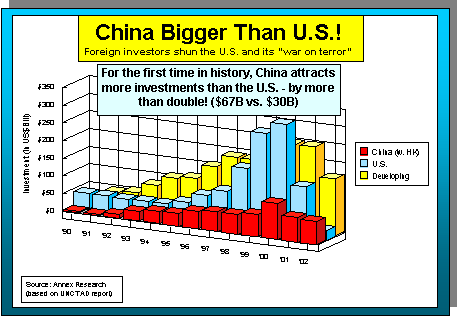
The preceding is one startling fact that
emanates from the latest United Nations report on global investments,
produced by its Geneva-based UNCTAD (United Nations Conference on Trade
and Development).
Worse for the U.S. workers, this is neither a
one-time phenomenon, nor a short-term trend that is likely to go away with
election of another president. Both
Republican and Democratic administrations have presided over the exports
of U.S. jobs and capital to China during the last 14 years (see “China:
The Real Cold War Winner,” Mar 2002), for example.
The trend started under George
Bush Sr., ironically after the Tiananmen Square massacre of
pro-democracy demonstrators (June 4, 1989).
And it accelerated
under Bill Clinton and “W” (Bush Jr.).
Ever since the end of the Cold War, China’s cheap labor and autocratic management have been magnets for foreign capital. China attracted more money than any other country, except for the U.S. Well, now you can also strike the word “except.”
In 2002, for example, China (including Hong
Kong), received about $67 billion in direct foreign investments – more
than double that of the U.S. ($30 billion).
That’s more money than all of Latin America, for example,
received in 2002 ($56 billion), and more than the combined total of
Eastern Europe (including Russia), and the Pacific, (including a surging Australia)
-$29 billion plus $24 billion respectively.
Interestingly,
that we are not only exporting American jobs to countries like China, but
that the U.S. multinationals are actually helping fund the process, are
not the headlines that grab one’s attention in the establishment media
reports, especially not in this presidential election year.
One might think that at least the “opposition” (Democratic)
candidates might choose to make the U.S. job and capital losses a bigger
issue than they have.
Think again. The preeminence of the Iraq war and the Bush income tax cuts on the Democratic agendas, at the expense of such dire long-term global and U.S. economic issues, only helps the Bush administration’s case. And it goes to show us that both parties’ frontrunners are racing for the same stable owners – the multinational bankers and companies who are behind these new trends.
For, were that not the case, you’d think that someone somewhere in the domestic political arena might have connected the dots, and told the American people the bitter truth – that they are paying with their jobs, lives and eroding living standards for the profits that the “death merchants” and other multinationals are reaping from Bush’s “war on terror.” And that now another Asian country is emerging as the new target for job exports, especially in the IT industry – India (see “A Passage to India,” July 22, 2003). To be sure, India is still far behind China when it comes to foreign investments ($24 billion vs. $596 billion in 1990-2002). But it is coming on strong, especially in the IT sector.
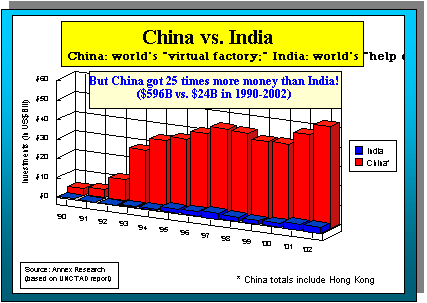
As if to underscore our point about American job exports overseas, IBM announced today (Jan 27) that it was cutting another 300 jobs in its storage division, mostly based in San Jose, California. Earlier this month, IBM also said it would lay off about 400 people in its software and services divisions. Overall, IBM said it plans to move about 3,000 jobs from the U.S. to other countries this year (also see "A Passage to India", July 22, 2003).
A Passage to India
The emergence of China as the world’s
“virtual factory,” and of India as the global “help desk,” means
that future will only get bleaker for the American workers. Sooner or later they may realize that “free trade” really
translates into corporate freedom to trade their jobs away in pursuit of
cheaper sources of goods and services.
In an interview with the San Jose Mercury News
last month, Craig Barrett, Intel’s CEO, for example, openly talked about
the integration of India, China and Russia into the world's economic
infrastructure. The three
countries have a combined population approaching three billion, he said[1].
More importantly, however, they have a well-educated labor force.
“I don't think this has been fully
understood by the United States,” said Barrett. “If you look at India,
China and Russia, they all have strong education heritages.
Even if you discount 90 percent of the people there as uneducated
farmers, you still end up with about 300 million people who are educated.
That's bigger than the U.S. work force.”
He added, “the big change today from what's
happened over the last 30 years is that it's no longer just low-cost labor
that you are looking at. It's
well-educated labor that can do effectively any job that can be done in
the United States… If you
see this increased competition for jobs, the immediate response to
competition is lower prices and that's lower wage rates,” Intel’s
Barrett concluded (see Bob
Herbert’s column, NY Times, Jan 26, 2004).
The bottom line is not only cheaper, but
sometimes also better quality of labor.
This is no accident.
It is a part of a carefully orchestrated long-term trend that
started with the 1965 Immigration Law which brought tens of millions of
new and different immigrants into the country.
in a 1997 Washington Times column, this writer called the 30+
year-process a “dumbing
down of America”.
“We can grapple with this problem now, and
try to develop workable solutions,” the Times columnist Bob Herbert
opined. “Or we can ignore
this fire in the basement of the national economy until it rages out of
our control.”
We
don’t know what “workable solutions” Herbert had in mind, except for
passing new laws that would restrict free movement of capital and jobs.
Which, of course, would cause an uproar by members of the World
Trade Organization, an international entity that the U.S. government has
pretty well crafted to suit its “free trade” mantra.
There is a case in point just as we speak.
As soon as the U.S. Senate tried to do something about it and come
up with some “workable solutions,” it was slammed by India, a big
beneficiary of IT job and capital exports.
“India's technology industry has attacked
proposed new US legislation that bans the outsourcing of federal work to
low cost countries arguing it is a protectionist measure contrary to the
spirit of free trade,” the London-based Financial
Times reported on Jan 25.
The move by the U.S. Senate coincides with
decisions by a number of foreign companies to halt further outsourcing to
India because of a new domestic tax ruling that would enable the Indian
government to tax part of their worldwide earnings.
So it isn’t a loss of American jobs, but the
greed of the Indian government, that may help develop a “workable
solution,” at least in the short term.
If it comes to pass, such a development would also underscore the
gullibility and short memories of some multinationals.
IBM, for example, also figured it was breaking
new grounds when it set up operations behind the Iron Curtain in the
1970s. But when Leonid
Brezhnev “did a Bush” and invaded Afghanistan in late 1979, Big Blue
and its investments were also left stranded behind the Iron Curtain, even
as its former chairman, Tom Watson Jr., served as the U.S. ambassador in
Moscow at the time.
Russia: Still a Bogey
Mixing business and politics is a practice as
old as either of these two endeavors.
Which means as old as sin. Nowhere
is that as evident as in Eastern Europe, or more specifically, the way
western business and political leaders have treated Russia.
Even though Eastern Europe has been the
only world region to grow foreign investments in the last two years,
Russia – the biggest country in the world, and by far the biggest
Eastern European economy – has been virtually ignored.
While investments in Eastern Europe surged by 15% in 2002 to $29
billion, Russia’s slumped by 2% to a mere $2.4 billion.
On a per capita basis, the discrepancy is even greater. The tiny Israel and Hungary, for example, got 21- and 13-times more foreign investment dollars per capita than did Russia. Yet Israel, for example, is one of the world’s most unstable countries. And capital, we are told, is a coward. Really?
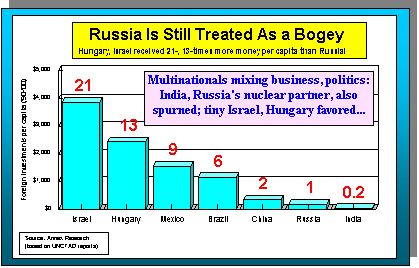
Well, evidently the U.S. capitalists wear
politically colored goggles. The
old antagonism toward the imperial, and later communist, Russia is seems
still around in America, the “world peace through world trade”
globalist slogan notwithstanding.
Here’s an example that illustrates the
point. What you’re about to
read is an excerpt from this writer’s diary about the May 1993 meeting
with Lou Gerstner, then newly appointed IBM CEO, and a former chairman of
RJR Nabisco and of American Express.
In
other words, Gerstner is supposed to be “a man of the world,”
especially considering his membership in all important globalist
organizations (Council on Foreign Relations, Bilderberger Group,
Trilateral Commission, and now the headship of Carlyle Group, a powerful
“New World Order” private corporation, the No.
11 defense contractor on Pentagon’s top 50 list, and a company
closely tied to the Bush family, among others).
After having covered some international
business issues to do with Japan and Australia (see “Gerstner:
The Untold Story,” Dec 2002), I switched the topic to Russia.
And here’s what followed…
I changed the subject to Russia as another example of an oversimplified manner in which the Western companies look at the world.
I referred to my conversation with an Indian economist, who divided the world into three major economic regions -- Europe, North America, Asia/Pacific. Yet, when I questioned him on the reasons certain countries were more successful than others, he said that one common denominator was the quality of the work force (i.e., technical education). He pointed to France and Japan as examples.
"That made a lot of sense to me," I said, "so I asked him how he could justify his three-region world economic model in view of the fact that the world's greatest pool of technical human resources is in Russia?"
He replied, “you're right, but
I still believe in the 'rule of three."
Everybody laughed.
"At least he was
honest," I said. I
proceeded to assert that the world economy in the 2000+
"will be a four-legged animal, not a three-legged creature we know
today."
"Unless we blow ourselves up
in the meantime," I added.
But, Gerstner did not seem to
have heard my last remark. By
this stage, he was deep in thought over what I had said before.
"But, the Russians aren't
really entrepreneurial people," he said, as if speaking half to
himself.
"Be careful about that,
Lou," I said. "You're
looking at 70 years of the Russian history during which the
entrepreneurship was outlawed. But,
you can't outlaw the genes!"
(from
this writer’s diary notes, May 1993)
Apart from the Russophobic attitude that
evidently permeates the globalists’ thinking, our 1993 exchange with
that Indian economist illustrates that the point Intel’s Barrett has
also just made. But while he
spoke about the supposedly better educated labor in China, India and
Russia, we have been pointing that out about Russia for over 11 years now,
mostly to our clients’ deaf ears.
While Chinese and Indian populaces represent
about 95% of the three billion-figure that Barrett had attributed to the
three countries, Russia’s work force with high education degrees is
probably bigger than the equivalent aggregate totals in China or India.
Its literacy rate is 99.6%, higher than even that of the U.S.
(97%), according to the CIA
2003 World Factbook. Compare
that to China’s 86% (79% for females), or India’s 59% (48% for
females). Yet we don’t see many IT firms rushing to open up “help
desks” or software labs in Russia, do we?
Why not?
Because Russia is evidently still considered a bogey by the powers
that be of the New World Order. No
wonder that the world’s largest country ranks dead last in Eastern
Europe in terms of the foreign investments as percent of GDP, according to
the UNCTAD report. Even the
war-torn Bosnia and Serbia are ahead of Russia.
The only exception to the general rule of
ignoring Russia in recent years has been last year’s British
Petroleum’s $7 billion investment into a joint venture with the fourth
largest Russian oil company (Tyumen Oil Co. and its affiliate Sidanco). Of course, the keyword here was British, i.e.,
European, not a U.S. multinational, that has broken ranks with the rest of
the pack who are trekking to China and India.
Global
Investments Drop Again
For the second year in a row, global direct investments dropped sharply in 2002, according to the UNCTAD data. They were down 21% to $824 billion, after plummeting 51% the year before from the $1.4 trillion peak in 2000.
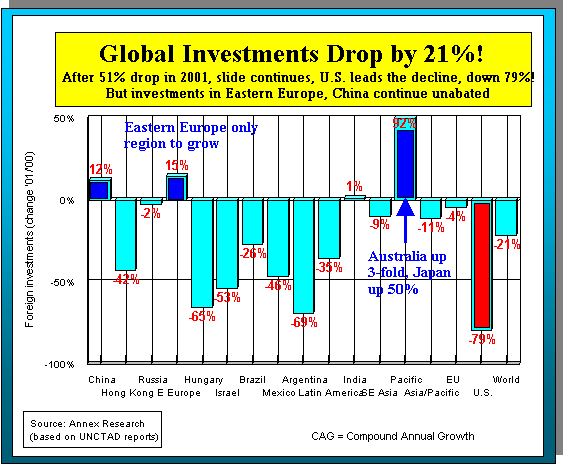
The only world region that bucked the general
declining trend was Eastern Europe, as we pointed out earlier in this
report. Investments there
jumped by 15% to a record $29 billion.
That’s still a relatively small figure in the global investment
scope, yet one that is just a shade below that of the U.S. ($30 billion),
a stunning dimension of the world’s repudiation of Washington’s “war
on terror” policy.
Foreign investments in the European Union
countries also ebbed in 2002 (down 4%), although much less than in the
U.S. (down 79%).
Latin America also took a beating in 2002
(down 35% to $56 billion), mostly due to the economic woes of Argentina,
and to a lesser extent of Brazil and Mexico – three largest economies in
the region.
Asia/Pacific investments were also down 11%, even though this region includes China, which as we saw earlier, experienced a 12% rise in foreign capita inflow. The Pacific region also benefited from more than a three-fold jump of investments in Australia (from $4 billion in 2001, to $14 billion in 2002), another country that is an exception to the generally declining global trends.

The cross-border mergers and acquisitions
(M&A), the main drivers of foreign direct investments in the past,
also slumped in 2002. They
were down 38% to $370 billion, after dropping 48% in 2001.
As a result, the M&A’s share of global
investments has also declined – from the high of 82% in 2000, to the 57%
level in 2002. But for the
entire post-Cold War era (1990-2002), the M&As still accounted for
more than two-thirds of all global investments (68% of $6.8 trillion),
attesting to the power that the investment bankers wield.
It is probably safe to
predict, therefore, that by the time we get around to doing this report a
year from now, both M&A and global investment indices are likely to be
pointing upward again.
Happy
Bob Djurdjevic
[1] Actually, the three countries’ population is just under 2.5 billion. But what’s a half a billion here, half a billion there, if you’re counting cheap labor.
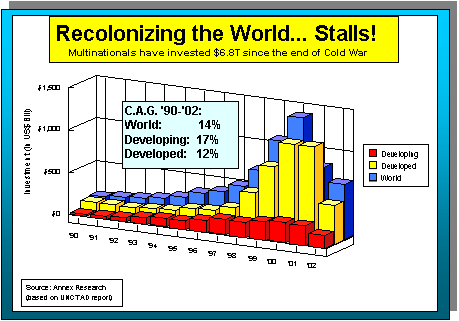
![]()
For additional Annex Research reports, check out...
200
4: "China Now Bigger Than U.S.!" (Jan 26)2003:
"A Passage to India" (July 22), Exodus from Equities (May 27), Money CAN Buy Longer Life (May 6), Global Investments Plummet (Jan 23)2002:
China: Real Cold War Winner (Mar 8, 2002); Bush League All-Stars (Jan 2002), SEC Launches Formal Probe of Wall Street Research (Apr 2002), Greed Bites Back (Nov 29, 2002), Salomon/Gutfreund: Wall Street Casino (June 21, 2002)A selection from prior years:
"Robber Baron" Era Is Back (Jan 2001), "A Cleaner, Neater World? Hardly. Deadlier, for Sure" (Feb 2000), More, Cheaper Service Jobs in the U.S. (Mar 1999), "From a Nation of Producers, to a Nation of Gamblers " (June 23, 1999), "When Will Wall Street's Bubble Burst?" (1998), "Wall St.'s Conquest of America" (1998), THE GREAT AMERICAN HOOVER (1997)![]()
Or just click on  and use appropriate
keywords.
and use appropriate
keywords.
Volume XX, Annex Bulletin 2004-03 Bob Djurdjevic, Editor P.O. Box 97100, Phoenix, Arizona
85060-7100 |
![]()
Home | Headlines | Annex Bulletins | Index 2004 | About Founder | Search | Feedback | Clips | Activism | Client quotes | Workshop | Columns | Subscribe
